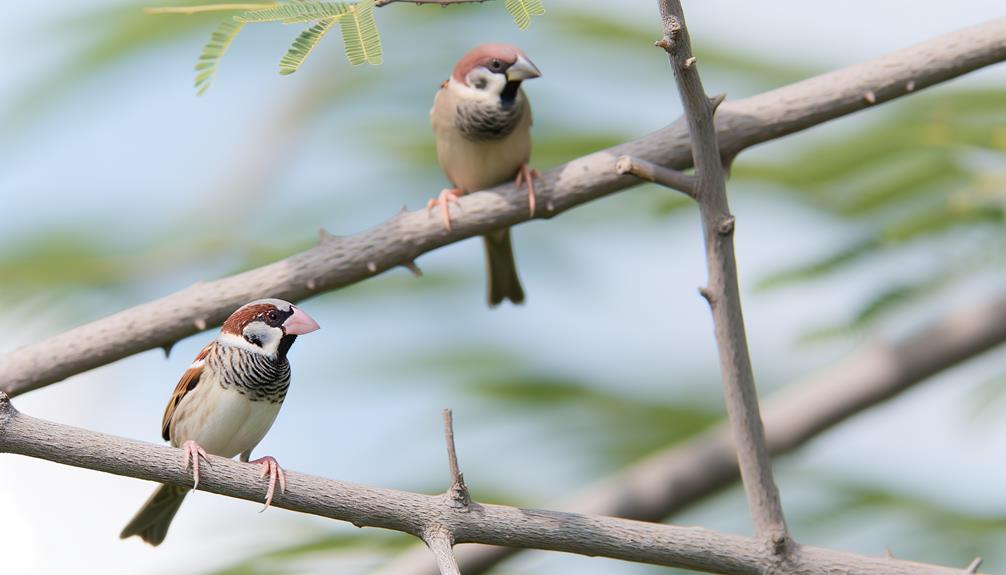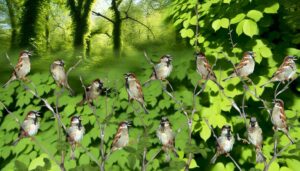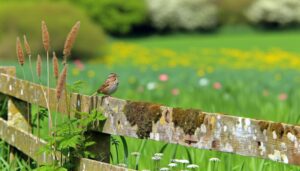5 Key Differences Between Field Sparrow vs Song Sparrow
Field Sparrows and Song Sparrows differ significantly in appearance and behavior. Field Sparrows have a grayish face and a distinct pink bill, while Song Sparrows are marked with a darker malar stripe and a central dark breast spot.
Field Sparrows inhabit open fields and prefer scattered shrubs, whereas Song Sparrows thrive in diverse habitats like wetlands and suburban gardens. Their feeding habits also diverge; Field Sparrows prefer grass seeds, switching to insects in breeding season, while Song Sparrows have a more varied diet.
When it comes to song, Field Sparrows emit clear, repetitive whistles, unlike the complex, varied calls of Song Sparrows. Explore further to uncover more about their ecological roles.

Key Takeaways
- Field Sparrows have a plain, grayish face with a pink bill, while Song Sparrows have a streaked brown and white face with a dark malar stripe.
- Field Sparrows inhabit open fields and meadows, whereas Song Sparrows are found in wetlands, thickets, and suburban gardens.
- Field Sparrows emit clear, simple whistled series, while Song Sparrows produce complex, rich songs with trills and varied phrases.
- Field Sparrows nest in low shrubs or tall grasses, using grasses and rootlets, whereas Song Sparrows nest in dense vegetation, incorporating leaves and bark strips.
- Field Sparrows are partial migrants moving to the southeastern U.S., while Song Sparrows' migration patterns vary by location, with northern populations migrating south for winter.
Physical Appearance
When comparing the physical appearance of the Field Sparrow and the Song Sparrow, one immediately notices distinct differences in their plumage and markings.
The Field Sparrow (Spizella pusilla) exhibits a more understated coloration, with a plain, grayish face and a distinctive pink bill. Its crown features a rusty cap, and its breast is mostly unmarked.
In contrast, the Song Sparrow (Melospiza melodia) boasts a more intricate pattern. It has a streaked brown and white face, with a notable dark malar stripe. The breast of the Song Sparrow is heavily streaked, converging into a central dark spot.
These visual distinctions are essential for accurate identification in the field, aiding ornithologists and bird enthusiasts alike in differentiating between the two species.
Habitat Preferences
Habitat preferences reveal that the Field Sparrow primarily inhabits open fields, meadows, and areas with scattered shrubs, whereas the Song Sparrow is commonly found in a wider range of environments, including wetlands, thickets, and suburban gardens.
The Field Sparrow's affinity for open, grassy areas with sparse vegetation allows it to avoid dense forests and urban settings. Scientific observations show that this species thrives in early successional habitats, which provide ample nesting sites and foraging opportunities.
On the other hand, the Song Sparrow displays remarkable habitat plasticity, frequenting marsh edges, dense underbrush, and even human-altered landscapes. This adaptability is supported by evidence indicating their successful colonization of diverse ecological niches, highlighting their broad ecological tolerance and behavioral flexibility.
Feeding Habits
In addition to their distinct habitat preferences, the Field Sparrow and Song Sparrow exhibit differing feeding habits that reflect their ecological adaptations.
The Field Sparrow primarily feeds on seeds and insects, favoring open grasslands where it forages on the ground. It demonstrates a preference for seeds of grasses and herbaceous plants, switching to insects like beetles and caterpillars during the breeding season for added protein.
In contrast, the Song Sparrow's diet is more varied, encompassing seeds, fruits, and invertebrates. It often forages in dense vegetation, utilizing its robust bill to crack open seeds and capture insects. Both species exhibit seasonal dietary shifts, but the Song Sparrow's broader habitat range enables it to exploit a wider array of food resources.
Song and Calls
Both Field Sparrows and Song Sparrows exhibit distinctive vocal patterns that serve as essential identifiers in their natural habitats.
Seasonal song variations are prominent, with males of both species altering their tunes during breeding periods to attract mates.
Additionally, call note differences, such as the Field Sparrow's series of accelerating whistles versus the Song Sparrow's complex, melodious phrases, provide vital auditory cues for species differentiation.
Distinctive Vocal Patterns
Field Sparrows emit a distinctive, clear whistled series that accelerates rapidly, resembling a bouncing ball, while Song Sparrows produce a complex, rich repertoire of trills, buzzes, and varied musical phrases.
Field Sparrows' song, characterized by a single, high-pitched note that speeds up, is often described as a 'ping-pong ball' bouncing. This simple, repetitive pattern aids in quick identification.
In contrast, Song Sparrows' vocalizations are intricate, with each song composed of multiple elements, including sharp chips and melodious warbles, contributing to their extensive song catalog. Observational studies reveal that Song Sparrows use these diverse calls for territory defense and mate attraction.
Their adaptability in vocalization demonstrates sophisticated neural mechanisms underpinning avian communication.
Seasonal Song Variations
Seasonal variations in the vocalizations of both Field Sparrows and Song Sparrows reflect changes in their reproductive cycles and environmental conditions, showcasing their adaptive communication strategies. During the breeding season, these sparrows exhibit enhanced song complexity and frequency to attract mates and establish territories.
In contrast, non-breeding seasons see a reduction in song activity and complexity, conserving energy.
Detailed observations reveal:
- Breeding Season: Increased song output and variability, serving territorial and courtship functions.
- Post-Breeding Season: Gradual decline in song activity as territorial disputes lessen.
- Winter Season: Minimal singing, focusing on survival rather than reproduction.
These patterns demonstrate a clear link between environmental pressures and vocal behavior, underlining the sparrows' flexible communication in response to seasonal demands.
Call Note Differences
Examining the call note differences between the Song Sparrow (Melospiza melodia) and the Field Sparrow (Spizella pusilla) reveals distinct acoustic signatures that serve specific functions in their communication repertoire.
Song Sparrows emit a sharp 'chimp' call, often used as an alarm signal, exhibiting a high frequency and rapid cadence. In contrast, Field Sparrows produce a soft, descending 'bouncing ball' call, characterized by a series of accelerating notes, primarily for mate attraction and territory defense.
Spectrographic analyses confirm these differences: Song Sparrows' calls show narrow bandwidths and high amplitude, while Field Sparrows' calls display broader frequency ranges and variable pitch. These variations illustrate how each species adapts its vocalizations to ecological and social needs.
Nesting Behavior
Field Sparrows prefer to nest in low shrubs or tall grasses, while Song Sparrows often choose dense vegetation or low trees.
Both species use grasses and rootlets for nest construction, but Field Sparrows incorporate finer materials.
Egg laying in Field Sparrows typically results in three to five eggs, whereas Song Sparrows lay four to six eggs per clutch.
Nesting Site Preferences
Both the Field Sparrow and the Song Sparrow exhibit distinct nesting site preferences. The Field Sparrow often chooses low shrubs or grass clumps, while the Song Sparrow favors dense vegetation near water sources. Field Sparrows typically select open, grassy areas that provide ideal conditions for their ground-level nests. Conversely, Song Sparrows prefer locations that offer more concealment and moisture, such as wetlands or stream banks.
Evidence-based observations reveal:
- Field Sparrows prefer areas with minimal tree canopy to reduce predator visibility.
- Song Sparrows often nest in thickets, which offer increased protection from predators.
- Both species exhibit site fidelity, often returning to similar nesting locations annually.
These preferences highlight their adaptive strategies to enhance offspring survival.
Nest Construction Materials
When building their nests, Field Sparrows primarily use grasses and rootlets. This allows them to create sturdy and well-concealed structures. On the other hand, Song Sparrows incorporate a mix of grasses, leaves, and bark strips in their nests. This diversity of materials potentially enhances nest insulation and camouflage for Song Sparrows.
Field Sparrows' nests are often more minimalistic, leveraging the flexibility and strength of fine grasses and rootlets for stability. In contrast, Song Sparrows demonstrate greater material diversity, incorporating leaves and bark strips. These material choices directly impact nest survival rates, with Song Sparrows' nests being better protected against predation.
The selection of materials reflects the adaptive strategies of these birds. Field Sparrows, favoring open, grassy habitats, require less concealment. In contrast, Song Sparrows found in denser vegetation benefit from enhanced nest concealment. Studies indicate that these differences in nesting materials and strategies play a crucial role in the survival of the nests.
Egg Laying Patterns
Egg laying patterns in sparrows reveal distinct temporal and quantitative variations between species, significantly influenced by environmental factors and adaptive behaviors. Field Sparrows typically lay eggs earlier in the season, from late April to early July, while Song Sparrows extend their egg-laying period from late March to mid-August. These differences are partly due to habitat preferences and climatic conditions.
Significantly, the clutch size also varies:
- Field Sparrows usually lay 3-5 eggs per clutch.
- Song Sparrows tend to lay 4-6 eggs per clutch.
- Both species may produce multiple broods per season, though Song Sparrows often have more.
Such variations suggest evolutionary adaptations to optimize reproductive success in their respective environments.
Migration Patterns
Unlike the Field Sparrow, which exhibits partial migratory behavior, the Song Sparrow demonstrates a more diverse range of migration patterns depending on its geographic location.
Northern populations of Song Sparrows migrate south during the winter months, showing a classic latitudinal migration. Conversely, populations residing in milder climates, such as the Pacific Coast, exhibit minimal to no migratory movement, remaining largely sedentary throughout the year.
Field Sparrows, on the other hand, generally migrate short distances, often to the southeastern United States, in response to colder weather. These behavioral variations are influenced by environmental conditions and resource availability, demonstrating the species' adaptability.
Both species' migration patterns are well-documented through banding studies and tracking technologies, providing critical insights into their ecological requirements and survival strategies.
Interaction With Humans
Field Sparrows and Song Sparrows exhibit varying degrees of interaction with humans, often influenced by habitat encroachment and urbanization, which profoundly impact their populations and behaviors. Field Sparrows, typically found in open fields and grasslands, face significant declines due to agricultural expansion and suburban development.
Conversely, Song Sparrows adapt more readily to human-altered environments, thriving in gardens and urban parks. Researchers have identified several key factors influencing these interactions:
- Habitat alteration: Urban sprawl reduces suitable nesting sites for Field Sparrows.
- Food availability: Song Sparrows benefit from bird feeders in residential areas.
- Predation pressures: Increased predator presence in urban settings affects both species.
These dynamics underscore the complex relationship between avian species and human activities.
Conclusion
In the grand tapestry of nature, the field sparrow and the song sparrow weave their distinct threads.
The field sparrow, with its subtle hues and open-field haunts, contrasts starkly with the song sparrow's bold streaks and varied habitats.
Their feeding habits, melodious calls, and migratory journeys reveal fascinating divergences.
These small yet mighty birds not only enrich ecosystems but also enchant human observers.
Understanding their differences deepens our appreciation for avian diversity and the intricate balance of our natural world.






